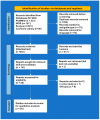Oral Microbiota Features in Subjects with Down Syndrome and Periodontal Diseases: A Systematic Review
- PMID: 34502159
- PMCID: PMC8431440
- DOI: 10.3390/ijms22179251
Oral Microbiota Features in Subjects with Down Syndrome and Periodontal Diseases: A Systematic Review
Abstract
Down syndrome (DS) is a genetic disorder associated with early-onset periodontitis and other periodontal diseases (PDs). The present work aimed to systematically review the scientific literature reporting studies in vivo on oral microbiota features in subjects with DS and related periodontal health and to highlight any correlation and difference with subjects not affected by DS, with and without PDs. PubMed, Web of Science, Scopus and Cochrane were searched for relevant studies in May 2021. The participants were subjects affected by Down syndrome (DS) with and without periodontal diseases; the study compared subjects with periodontal diseases but not affected by DS, and DS without periodontal diseases; the outcomes were the differences in oral microbiota/periodontopathogen bacterial composition among subjects considered; the study design was a systematic review. Study quality was assessed with risk of bias in non-randomized studies of interventions (ROBINS-I). Of the 954 references retrieved, 26 studies were considered. The conclusions from the qualitative assessment of the papers revealed an increasing knowledge over the last years of the microbiota associated with DS and their periodontal diseases, in comparison with healthy subjects and subjects with other kinds of mental disabilities. Few data have emerged on the mycobiome and virobiome of DS, hence, further investigations are still necessary.
Keywords: Down syndrome; bacteria; dental biofilm; dental plaque; fungi; gingivitis; microbiome; microbiota; periodontal diseases; periodontitis; trisomy 21; virus.
Conflict of interest statement
The authors declare no conflict of interest.
Figures



References
Publication types
MeSH terms
LinkOut - more resources
Full Text Sources
Medical
Miscellaneous

